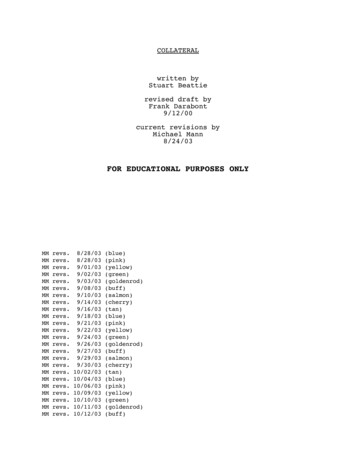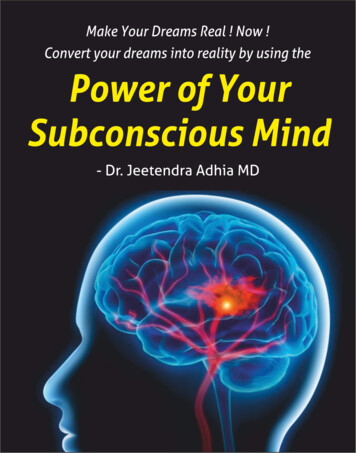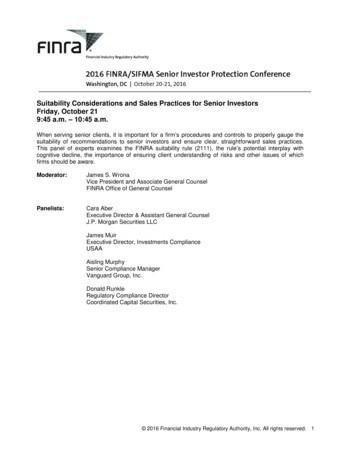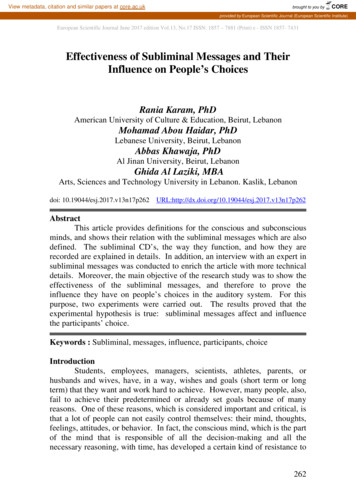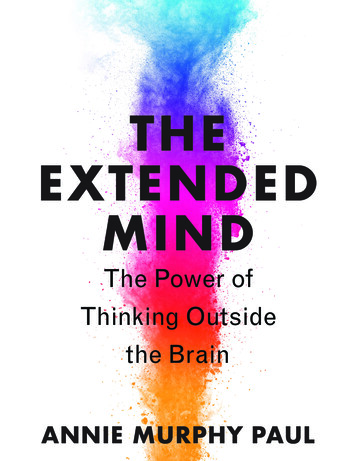
Transcription
THE EXTENDED MIND 1
THE EXTENDED MIND:THE POWER OF THINKINGOUTSIDE THE BRAINB Y A N N I E M U R P H Y PA U LForthcoming fromHoughton Mifflin Harcourtin June 2021A bold new book reveals how we can tap the intelligence that exists beyondour brains—in our bodies, our surroundings, and our relationships“Use your head.” That’s what we tell ourselves when facing a tricky problem or a difficultproject. But a growing body of research indicates that we’ve got it exactly backwards.What we need to do, says acclaimed science writer Annie Murphy Paul, is think outsidethe brain. A host of “extra-neural” resources—the feelings and movements of our bodies,the physical spaces in which we learn and work, and the minds of those around us—canhelp us focus more intently, comprehend more deeply, and create more imaginatively.In The Extended Mind, Paul delves into the research behind this exciting new visionof human ability, exploring the findings of neuroscientists, cognitive scientists, andpsychologists. She excavates the secret history of how artists, scientists, and authors haveemployed mental extensions to solve problems, make discoveries, and create new works.And she explains how readers can incorporate outside-the-brain thinking into theireveryday lives. In the tradition of Howard Gardner’s Frames of Mind or Daniel Goleman’sEmotional Intelligence, The Extended Mind offers a dramatic new view of how our mindswork, full of practical advice on how to think better.Annie Murphy Paul is an acclaimed science writer whosework has appeared in the New York Times Magazine, ScientificAmerican, and the Best American Science Writing, among manyother publications. She is the author of Origins, selected by theNew York Times Book Review as a “Notable Book,” and The Cultof Personality, hailed by Malcolm Gladwell in the New Yorker asa “fascinating new book.” Currently a fellow at New America, shehas also received the Spencer Education Reporting Fellowship and the Rosalynn CarterMental Health Journalism Fellowship. Paul has spoken to audiences around the worldabout learning and cognition; her TED Talk has been viewed by more than 2.6 millionpeople. A graduate of Yale University and the Columbia University Graduate School ofJournalism, she has served as a lecturer at Yale University and as a senior advisor at theYale University Poorvu Center for Teaching and Learning.
THE EXTENDED MINDTHE POWER OF THINKINGOUTSIDE THE BRAINAnnie Murphy PaulTo be published byHoughton Mifflin Harcourtin June 2021
Copyright 2021 by Anne PaulAll rights reserved
CONTENTSPrologueIntroduction: Thinking Outside the Brain715PA R T I : T H I N K I N G W I T H O U R B O D I E S1.Thinking with Sensations362.Thinking with Movement633.Thinking with Gesture90PA R T I I : T H I N K I N G W I T H O U R S U R R O U N D I N G S4.Thinking with Natural Spaces1165.Thinking with Built Spaces1426.Thinking with the Space of Ideas170PA R T I I I : T H I N K I N G W I T H O U R R E L AT I O N S H I P S7.Thinking with Experts1968.Thinking with Peers2239.Thinking with Groups250Conclusion283
P R O LO G U EWhen you’re writing a book about how to think well, your sources—the cognitive scientists, psychologists, biologists, neuroscientists, andphilosophers who all have something to contribute on the subject—will often seem to be speaking, via their work, directly to you: Yes,you there, writing a book! They cajole and insist, they argue anddebate, they issue warnings and pass judgment; as you lay out theirrecommendations for the reader, they inquire pointedly: Are you taking your own advice?I entered into one such intimate exchange when I read, with a joltof recognition, a passage written more than 130 years ago; it was asif the author were reaching through the pages that lay open on mydesk. Making the meeting more intense, the writer in question was adistinctly intimidating character: the German philosopher FriedrichNietzsche, he of the severe gaze and vaguely sinister mustache.“How quickly we guess how someone has come by his ideas,”Nietzsche slyly observed, “whether it was while sitting in front of hisinkwell, with a pinched belly, his head bowed low over the paper—inwhich case we are quickly finished with his book, too! Cramped intestines betray themselves—you can bet on that—no less than closetair, closet ceilings, closet narrowness.”The room in which I was writing suddenly seemed rather airlessand small.I encountered his words as I was working on a chapter abouthow bodily movement affects the way we think. The quote fromNietzsche appears in a book titled A Philosophy of Walking, by theTHE EXTENDED MIND 7
contemporary French philosopher Frédéric Gros; Gros has his ownthoughts to add. Don’t think of a book as issuing only from an author’s head, he advises. “Think of the scribe’s body: his hands, hisfeet, his shoulders and legs. Think of the book as an expression ofphysiology. In all too many books the reader can sense the seatedbody, doubled up, stooped, shriveled in on itself.”My seated body shifted guiltily in its chair, which it had occupiedall morning.Far more conducive to the act of creation, Gros continues, is “thewalking body”—which, he says, is “unfolded and tensed like a bow:opened to wide spaces like a flower to the sun.” Nietzsche, he remindsus, wrote that we should “sit as little as possible; do not believe anyidea that was not born in the open air and of free movement.”The philosophers were ganging up on me; I closed my laptop andwent for a walk.I was acting not only on their say-so, of course; by this point inmy research I had read dozens of empirical studies showing that about of physical activity sharpens our attention, improves our memory, and enhances our creativity. And in fact, I found that the forward movement of my legs, the flow of images past my eyes, theslight elevation of my heart rate did work some kind of change on mymind. Upon sitting back down at my desk, I wasted no time resolvinga knotty conceptual problem that had tormented me all morning. (Ican only hope that the prose I produced also “retains and expressesthe energy, the springiness of the body,” in Gros’s formulation.)Could my brain have solved the problem on its own, or did it requirethe assist provided by my ambulatory limbs?Our culture insists that the brain is the sole locus of thinking,a cordoned-off space where cognition happens, much as the workings of my laptop are sealed inside its aluminum case. This bookargues otherwise: it holds that the mind is something more like thenest-building bird I spotted on my walk, plucking a bit of string here,a twig there, constructing a whole out of available parts. For humans these parts include, most notably, the feelings and movements8 THE EXTENDED MIND
of our bodies; the physical spaces in which we learn and work; andthe other minds with which we interact—our classmates, colleagues,teachers, supervisors, friends. Sometimes all three elements come together in especially felicitous fashion, as they did for the brilliantintellectual team of Amos Tversky and Daniel Kahneman. The twopsychologists carried out much of their groundbreaking work onheuristics and biases—the human mind’s habitual shortcuts anddistortions—by talking and walking together, through the bustlingstreets of Jerusalem or along the rolling hills of the California coast.“I did the best thinking of my life on leisurely walks with Amos,”Kahneman has said.Many tomes have been written on human cognition, many theories proposed and studies conducted (Tversky and Kahneman’samong them). These efforts have produced countless illuminating insights, but they are limited by their assumption that thinking happensonly inside the brain. Much less attention has been paid to the wayspeople use the world to think: the gestures of the hands, the space ofa sketchbook, the act of listening to someone tell a story, or the taskof teaching someone else. These “extra-neural” inputs change theway we think; it could even be said that they constitute a part of thethinking process itself. But where is the chronicle of this mode of cognition? Our scientific journals mostly proceed from the premise thatthe mental organ is a disembodied, placeless, asocial entity, a “brainin a vat”;our history books spin tales that attribute world-changingbreakthroughs to individual men, thinking great thoughts on theirown. Yet a parallel narrative has existed in front of us all along—akind of secret history of thinking outside the brain. Scientists, artists,authors; leaders, inventors, entrepreneurs: they’ve all used the worldas raw material for their trains of thought. This book aims to exhumethat hidden saga, reclaiming its rightful place in any full accountingof how the human race has achieved its remarkable feats of intellectand creativity.We’ll learn about how geneticist Barbara McClintock made herNobel Prize–winning discoveries by imaginatively “embodying” theTHE EXTENDED MIND 9
plant chromosomes she studied, and about how pioneering psychotherapist and social critic Susie Orbach senses what her patients arefeeling by tuning in to the internal sensations of her own body (acapacity known as interoception). We’ll contemplate how biologistJames Watson determined the double-helix structure of DNA byphysically manipulating cardboard cutouts he’d made himself, andhow author Robert Caro plots the lives of his biographical subjectson an intricately detailed wall-sized map. We’ll explore how virologist Jonas Salk was inspired to complete his work on a polio vaccinewhile wandering a thirteenth-century Italian monastery, and how theartist Jackson Pollock set off a revolution in painting by trading hisapartment in frenetic downtown Manhattan for a farmhouse on theverdant south fork of Long Island. We’ll find out how Pixar directorBrad Bird creates modern movie classics like Ratatouille and TheIncredibles by arguing—vehemently—with his longtime producer,and how physicist Carl Wieman, another Nobel Prize winner, figuredout that inducing his students to talk with one another was the keyto getting them to think like scientists.Such stories push back against the prevailing assumption thatthe brain can, or should, do it all on its own; they are vivid testimony to the countervailing notion that we think best when wethink with our bodies, our spaces, and our relationships. But as withFriedrich Nietzsche’s commendation of the virtues of walking, theevidence supporting the efficacy of thinking outside the brain is farfrom merely anecdotal. Research emerging from three related areasof investigation has convincingly demonstrated the centrality of extra-neural resources to our thinking processes.First, there is the study of embodied cognition, which exploresthe role of the body in our thinking: for example, how making handgestures increases the fluency of our speech and deepens our understanding of abstract concepts. Second, there is the study of situatedcognition, which examines the influence of place on our thinking: forinstance, how environmental cues that convey a sense of belonging,or a sense of personal control, enhance our performance in that space.10 THE EXTENDED MIND
And third, there is the study of distributed cognition, which probesthe effects of thinking with others—such as how people working ingroups can coordinate their individual areas of expertise (a processcalled “transactive memory”), and how groups can work together toproduce results that exceed their members’ individual contributions(a phenomenon known as “collective intelligence”).As a journalist who has covered research in psychology and cognitive science for more than twenty years, I read the findings generated by these fields with growing excitement. Together they seemedto indicate that it’s the stuff outside our heads that makes us smart—aproposition with enormous implications for what we do in education,in the workplace, and in our everyday lives. The only problem: therewas no “together,” no overarching framework that organized thesemultitudinous results into a coherent whole. Researchers workingwithin these three disciplines published in different journals and presented at different conferences, rarely drawing connections amongtheir areas of specialization. Was there some unifying idea that couldpull together these deeply intriguing findings?Once again a philosopher came to my rescue: this time it wasAndy Clark, professor of cognitive philosophy at the University ofSussex in England. In 1998 Clark had co-written a paper titled “TheExtended Mind,” which opened with a deceptively simple question:“Where does the mind stop and the rest of the world begin?” Clarkand his coauthor, philosopher David Chalmers, noted that we havetraditionally assumed that the mind is contained within the head—but, they argued, “there is nothing sacred about skull and skin.”Elements of the world outside may effectively act as mental “extensions,” allowing us to think in ways our brains could not manage ontheir own.Clark and Chalmers initially focused their analysis on the waytechnology can extend the mind—a proposal that quickly made theleap from risibly preposterous to self-evidently obvious, once theirreaders acquired smartphones and began offloading large chunksof their memories onto their new devices. (Fellow philosopher NedTHE EXTENDED MIND 11
Block likes to say that Clark and Chalmers’s thesis was false when itwas written in 1998 but subsequently became true—perhaps in 2007,when Apple introduced the first iPhone.)Yet as early as that original paper, Clark hinted that other kindsof extensions were possible. “What about socially extended cognition?”he and Chalmers asked. “Could my mental states be partlyconstituted by the states of other thinkers? We see no reason whynot.” In the years that followed, Clark continued to enlarge his conception of the kinds of entities that could serve as extensions of themind. He observed that our physical movements and gestures play“an important role in an extended neural-bodily cognitive economy”; he noted that humans are inclined to create “designer environments”—carefully appointed spaces “that alter and simplify thecomputational tasks which our brains must perform in order to solvecomplex problems.” Over the course of many more published papersand books, Clark mounted a broad and persuasive argument againstwhat he called the “brainbound” perspective—the view that thinkinghappens only inside the brain—and in favor of what he called the“extended” perspective, in which the rich resources of our world canand do enter into our trains of thought.Consider me a convert. The notion of the extended mind seizedmy imagination and has not yet released its grip. During my manyyears of reporting, I had never before encountered an idea thatchanged so much about how I think, how I work, how I parent, howI navigate everyday life. It became apparent to me that Andy Clark’sbold proposal was not (or not only!) the esoteric thought experimentof an ivory tower philosopher; it was a plainly practical invitation tothink differently and better. As I began to catalog the dozens of techniques for thinking outside the brain that researchers have tested andverified, I eagerly incorporated them into my own repertoire.These include methods for sharpening our interoceptive sense, soas to use these internal signals to guide our decisions and manage ourmental processes; they encompass guidelines for the use of specifictypes of gesture, or particular modes of physical activity, to enhance12 THE EXTENDED MIND
our memory and attention. This research offers instructions on usingtime in nature to restore our focus and increase our creativity, aswell as directions for designing our learning and working spaces forgreater productivity and performance. The studies we’ll cover describe structured forms of social interaction that allow other people’scognition to augment our own; they also supply guidance on how tooffload, externalize, and dynamically interact with our thoughts—amuch more effective approach than doing it all “in our heads.”In time I came to recognize that I was acquiring a second education—one that is increasingly essential but almost always overlookedin our focus on educating the brain. Over many years of elementary school, high school, and even college and graduate school, we’renever explicitly taught to think outside the brain; we’re not shownhow to employ our bodies and spaces and relationships in the serviceof intelligent thought. Yet this instruction is available if we knowwhere to look; our teachers are the artists and scientists and authorswho have figured out these methods for themselves, and the researchers who are, at last, making these methods the object of study.For my own part, I’m convinced that I could not have writtenthis book without the help of the practices detailed within it. That’snot to say that I didn’t sometimes fall back into our culture’s defaultposition. Before Friedrich Nietzsche’s fortuitous intervention thatmorning, I was in full brainbound mode, my “head bowed low” overmy keyboard, working my poor brain ever harder instead of lookingfor opportunities to extend it. I’m grateful for the nudge my researchsupplied; it’s that gentle push in a more productive direction that thisbook seeks to offer its own readers.Frédéric Gros, the French philosopher who brought Nietzsche’swords to my attention, maintains that thinkers ought to get movingin a “quest for a different light.”As he observes, “Libraries are always too dark,” and books written among the stacks manifest thisdull dimness—while “other books reflect piercing mountain light, orthe sea sparkling in sunshine.” It’s my hope that this book will cast adifferent light, bring a bracing gust of fresh air to the thinking we doTHE EXTENDED MIND 13
as students and workers, as parents and citizens, as leaders and creators. Our society is facing unprecedented challenges, and we’ll needto think well in order to solve them. The brainbound paradigm nowso dominant is clearly inadequate to the task; everywhere we look wesee problems with attention and memory, with motivation and persistence, with logical reasoning and abstract thinking. Truly originalideas and innovations seem scarce; engagement levels at schools andin companies are low; teams and groups struggle to work together inan effective and satisfying way.I’ve come to believe that such difficulties result in large part froma fundamental misunderstanding of how—and where—thinking happens. As long as we settle for thinking inside the brain, we’ll remainbound by the limits of that organ. But when we reach outside it withintention and skill, our thinking can be transformed. It can becomeas dynamic as our bodies, as airy as our spaces, as rich as our relationships—as capacious as the whole wide world.14 THE EXTENDED MIND
INTRODUCTIONThinking Outside the BrainUse your head.How many times have you heard that phrase? Perhaps you’veeven urged it on someone else—a son or daughter, a student, an employee. Maybe you’ve muttered it under your breath while strugglingwith an especially tricky problem, or when counseling yourself toremain rational: Use your head!The command is a common one, issued in schools, in the workplace, amid the trials of everyday life. Its refrain finds an echo inculture both high and low, from Auguste Rodin’s The Thinker, chinresting thoughtfully on fist, to the bulbous cartoon depiction of thebrain that festoons all manner of products and websites—educationaltoys, nutritional supplements, cognitive fitness exercises. When wesay it, we mean: call on the more than ample powers of your brain,draw on the magnificent lump of tissue inside your skull. We place alot of faith in that lump; whatever the problem, we believe, the braincan solve it.But what if our faith is misplaced? What if the directive to “useyour head,” ubiquitous though it may be, is misguided? A burgeoning body of research suggests that we’ve got it exactly backwards. Asit is, we use our brains entirely too much—to the detriment of ourability to think intelligently. What we need to do is think outside thebrain.Thinking outside the brain means skillfully engaging entities external to our heads—the feelings and movements of our bodies, thephysical spaces in which we learn and work, and the minds of theTHE EXTENDED MIND 15
other people around us—drawing them into our own mental processes. By reaching beyond the brain to recruit these “extra-neural”resources, we are able to focus more intently, comprehend moredeeply, and create more imaginatively—to entertain ideas that wouldbe literally un-thinkable by the brain alone. It’s true that we’re moreaccustomed to thinking about our bodies, our spaces, and our relationships. But we can also think with and through them—by usingthe movements of our hands to understand and express abstract concepts, for example, or by arranging our workspace in ways that promote idea generation, or by engaging in social practices like teachingand storytelling that lead to deeper understanding and more accurate memory. Rather than exhorting ourselves and others to use ourheads, we should be applying extra-neural resources to the project ofthinking outside the skull’s narrow circumference.But wait, you may be asking. What’s the need? Isn’t the brain, onits own, up to the job? Actually, no. We’ve been led to believe that thehuman brain is an all-purpose, all-powerful thinking machine. We’redeluged with reports of discoveries about the brain’s astounding abilities, its lightning quickness and its protean plasticity; we’re told thatthe brain is a fathomless wonder, “the most complex structure inthe universe.” But when we clear away the hype, we confront thefact that the brain’s capacities are actually quite constrained and specific. The less heralded scientific story of the past several decades hasbeen researchers’ growing awareness of the brain’s limits. The humanbrain is limited in its ability to pay attention, limited in its capacity toremember, limited in its facility with abstract concepts, and limited inits power to persist at a challenging task.Importantly, these limits apply to everyone’s brain. It’s not amatter of individual differences in intelligence; it’s a matter of thecharacter of the organ we all possess, its biological nature and itsevolutionary history. The brain does do a few things exquisitelywell—things like sensing and moving the body, navigating throughspace, and connecting with other humans. These activities it canmanage fluently, almost effortlessly. But accurately recalling complex16 THE EXTENDED MIND
information? Engaging in rigorous logical reasoning? Grasping abstract or counterintuitive ideas? Not so much.Here we arrive at a dilemma—one that we all share: The modern world is extraordinarily complex, bursting with information,built around non-intuitive ideas, centered on concepts and symbols.Succeeding in this world requires focused attention, prodigious memory, capacious bandwidth, sustained motivation, logical rigor, andproficiency with abstractions. The gap between what our biologicalbrains are capable of, and what modern life demands, is large andgetting larger each day. With every experimental discovery, the divide between the scientific account of the world and our intuitive“folk” understanding grows more pronounced. With every terabyteof data swelling humanity’s store of knowledge, our native facultiesare further outstripped. With every twist of complexity added to theworld’s problems, the naked brain becomes more unequal to the taskof solving them.Our response to the cognitive challenges posed by contemporarylife has been to double down on what the philosopher Andy Clarkcalls “brainbound” thinking—those very capacities that are, on theirown, so woefully inadequate. We urge ourselves and others to grit itout, bear down, “just do it”—to think harder. But, as we often find toour frustration, the brain is made of stubborn and unyielding stuff, itsvaunted plasticity notwithstanding. Confronted by its limits, we mayconclude that we ourselves (or our children or our students or ouremployees) are simply not smart enough, or not “gritty” enough. Infact, it’s the way we handle our mental shortcomings—which are, remember, endemic to our species—that is the problem. Our approachconstitutes an instance of (as the poet William Butler Yeats put it inanother context) “the will trying to do the work of the imagination.”The smart move is not to lean ever harder on the brain but to learnto reach beyond it.In The Middle Class Gentleman, a comedy written by the seventeenth-century French playwright Molière, the would-be aristocratMonsieur Jourdain is delighted by a realization that follows upon hisTHE EXTENDED MIND 17
learning the difference between prose and verse. “By my faith! Formore than forty years I have been speaking prose without knowinganything about it!” he exclaims. Likewise, we may be impressed tolearn that we have long been drawing extra-neural resources into ourthinking processes—that we already think outside the brain.That’s the good news. The bad news is that we often do it haphazardly, without much intention or skill. It’s no wonder this is the case.Our efforts at education and training, as well as management andleadership, are aimed almost exclusively at promoting brainboundthinking. Beginning in elementary school, we are taught to sit still,work quietly, think hard—a model for mental activity that will prevail during all the years that follow, through high school and collegeand into the workplace. The skills we develop and the techniques weare taught are those that involve using our heads: committing information to memory, engaging in internal reasoning and deliberation,endeavoring to self-discipline and self-motivate.Meanwhile, there is no corresponding cultivation of our abilityto think outside the brain—no instruction, for instance, in how totune in to the body’s internal signals, sensations that can profitablyguide our choices and decisions. We’re not trained to use bodilymovements and gestures to understand highly conceptual subjectslike science and mathematics, or to come up with novel and originalideas. Schools don’t teach students how to restore their depleted attention with exposure to nature and the outdoors, or how to arrangetheir study spaces so that they extend intelligent thought. Teachersand managers don’t demonstrate how abstract ideas can be turnedinto physical objects that can be manipulated and transformed in order to achieve insights and solve problems. Employees aren’t shownhow the social practices of imitation and vicarious learning canshortcut the process of acquiring expertise. Classroom groups andworkplace teams aren’t coached in scientifically validated methodsof increasing the collective intelligence of their members. Our abilityto think outside the brain has been left almost entirely uneducatedand undeveloped.18 THE EXTENDED MIND
This oversight is the regrettable result of what has been called our“neurocentric bias”—that is, our idealization and even fetishizationof the brain—and our corresponding blind spot for all the ways cognition extends beyond the skull. (As the comedian Emo Philips hasremarked: “I used to think that the brain was the most wonderfulorgan in my body. Then I realized who was telling me this.”) Seenfrom another perspective, however, this near-universal neglect represents an auspicious opportunity—a world of unrealized potential.Until recently, science shared the larger culture’s neglect of thinkingoutside the brain. But this is no longer the case. Psychologists, cognitive scientists, and neuroscientists are now able to provide a clear picture of how extra-neural inputs shape the way we think. Even morepromising, they offer practical guidelines for enhancing our thinkingthrough the use of these outside-the-brain resources. Such developments are unfolding against the backdrop of a broader shift in howwe view the mind—and, by extension, how we understand ourselves.But first—to gain a sense of where we’ve been and where we’reheaded, it’s worth taking several steps back in time, to the momentwhen our current ideas about the brain were born. On February 14, 1946, a breathless bustle filled the halls of theMoore School of Electrical Engineering in Philadelphia. On thisday, the school’s secret jewel was going to be revealed to the world:the ENIAC. Inside a locked room at Moore hummed the ElectronicNumerical Integrator and Computer, the first machine of its kind capable of performing calculations at lightning speed. Weighing thirtytons, the massive ENIAC used around eighteen thousand vacuumtubes, employed about six thousand switches, and encompassedupwards of half a million soldered joints; it had taken more than200,000 man-hours to build.The bus-sized contraption was the brainchild of John Mauchlyand J. Presper Eckert Jr., two young scientists at the University ofPennsylvania, Moore’s parent institution. With funding from the USTHE EXTENDED MIND 19
Army, the ENIAC had been developed for the purpose of computing artillery trajectories for American gunners fighting the war inEurope. Compiling trajectory tables—necessary for the effective useof new weapons being introduced by the military—was a laboriousprocess, requiring the service of teams of human “computers” working in shifts around the clock. A machine that could do their job withspeed and accuracy would give the army an invaluable edge.Now, six months after V-Day, the demands of wartime were giving way to the needs of an expanding economy, and Mauchly andEckert had called a press conference to introduce their invention tothe world. The two men had prepared for the event with deliberate care, and no small amount of stagecraft. As the ENIAC chuggedaway at a given task, some three hundred neon lights built into themachine’s accumulators flickered and flashed. Presper Eckert, knownto all
about learning and cognition; her TED Talk has been viewed by more than 2.6 million people. A graduate of Yale University and the Columbia University Graduate School of Journalism, she has served as a lecturer at Yale University and as a senior advisor at the Yale University Po



